X


> ARTICLES
Early signs of HIV: Timely recognition and actions
By Slava Fuzayloff | Published on Saturday 20, 2024
Acute HIV Symptoms Overview
What is acute HIV?
It is the initial stage of HIV infection, occurring within a few days of exposure and typically lasting for a few weeks. This stage is also called primary HIV infection or early HIV. [1] How to Recognize and Treat Acute HIV Syndrome. American Family Physician. https://www.aafp.org/pubs/afp/issues/1999/0801/p535.html
Early symptoms of HIV
Symptoms associated with early HIV infection appear within 2–4 weeks of exposure and usually include:
[1, 2]
How to Recognize and Treat Acute HIV Syndrome. American Family Physician.
https://www.aafp.org/pubs/afp/issues/1999/0801/p535.html
Acute HIV-1 Infection in the Southeastern United States: A Cohort Study. PubMed Central.
https://www.ncbi.nlm.nih.gov/pmc/articles/PMC3537297/
✓ Fever and chills
✓ Fatigue
✓ Rash
✓ Swollen lymph nodes
✓ Headache
✓ Mouth sores
✓ Oral thrush
✓ Sore throat
✓ Muscle pain
✓ Unexplained weight loss
✓ Nausea and vomiting
How common are early HIV symptoms?
About 50–90% of patients report at least one symptom of acute HIV infection. The most common of these are fever (up to 90% of cases), fatigue (up to 90% of cases), rash (up to 70% of cases), headache (up to 70% of cases), and swollen lymph nodes (up to 70% of cases). Further estimates of the prevalence of acute HIV symptoms are described below.
[1, 2]
How to Recognize and Treat Acute HIV Syndrome. American Family Physician.
https://www.aafp.org/pubs/afp/issues/1999/0801/p535.html
Acute HIV-1 Infection in the Southeastern United States: A Cohort Study. PubMed Central.
https://www.ncbi.nlm.nih.gov/pmc/articles/PMC3537297/

Things you need to know about early HIV symptoms
The section below summarizes the most important facts and details about the early HIV symptoms.
Fever and chills
How common is fever in early HIV?
Fever is one of the most common and consistent signs of acute HIV infection, affecting more than 75% of patients. Most studies suggest that this number may be as high as 90% (some studies even show that 100% of patients had a fever in the early stages of infection). Sometimes, fever can be accompanied by chills.
[1, 3]
How to Recognize and Treat Acute HIV Syndrome. American Family Physician.
https://www.aafp.org/pubs/afp/issues/1999/0801/p535.html
Primary HIV infection. International Journal of STD & AIDS.
https://sci-hub.se/10.1258/0956462021924613
How soon in the disease process does fever occur?
Fever is one of the earliest signs of early HIV infection among symptomatic patients. It occurs within 2-4 weeks after exposure to HIV. [4] What to know about a fever and HIV. MedicalNewsToday. https://www.medicalnewstoday.com/articles/323845
How severe is the fever?
It is usually mild, around 101.6 F (38.68C) on average. However, about 30% of patients may experience a temperature above 103.6 F (39.8C). [3] Primary HIV infection. International Journal of STD & AIDS. https://sci-hub.se/10.1258/0956462021924613
How long does the fever last in acute HIV infection?
The fever lasts about 7-14 days (average ten days) but may last only a day or two. [5] Features of fever caused by HIV virus. VinMec. https://www.vinmec.com/en/news/health-news/general-health-check/features-of-fever-caused-by-hiv-virus/
Fatigue
How common is fatigue in early HIV?
Fatigue is another common symptom of early HIV infection, reported by up to 90% of patients. [1] How to Recognize and Treat Acute HIV Syndrome. American Family Physician. https://www.aafp.org/pubs/afp/issues/1999/0801/p535.html
How soon in the disease process does fatigue occur?
Fatigue is another common symptom of early HIV infection, reported by up to 90% of patients. [1] It appears within 2-4 weeks after exposure to the infection. https://www.aafp.org/pubs/afp/issues/1999/0801/p535.html
Rash
How common is the rash in early HIV?
Skin rash appears among 23-70% of patients with acute HIV infection. [3] Primary HIV infection. International Journal of STD & AIDS. https://sci-hub.se/10.1258/0956462021924613
How soon does acute HIV rash occur?
Patients develop a rash within 2-4 weeks of infection. This often occurs 2-3 days after the fever. [6] Patient education: Symptoms of HIV (Beyond the Basics). UpToDate. https://www.uptodate.com/contents/symptoms-of-hiv-beyond-the-basics
What kind of rash is it?
Typically, people with early-stage HIV have a macular or maculopapular rash. It is a mixture of flat and raised lesions up to 10 mm in diameter that are reddish in fair-skinned patients or purplish in dark-skinned patients. [3] Primary HIV infection. International Journal of STD & AIDS. https://sci-hub.se/10.1258/0956462021924613
HIV affects immunity, which can trigger the appearance of other skin conditions, such as roseola-like rash, diffuse urticaria (hives), peeling of soles and palms, and pustular-vesicular lesions. These conditions are non-specific; various illnesses can cause them and cannot indicate HIV infection. [3] Primary HIV infection. International Journal of STD & AIDS. https://sci-hub.se/10.1258/0956462021924613
Which body parts does early HIV rash affect?
The rash typically occurs on the trunk, face, and upper chest (in descending order of frequency). However, it can also spread and affect the lower and upper extremities. [3] Primary HIV infection. International Journal of STD & AIDS. https://sci-hub.se/10.1258/0956462021924613
How long does it last?
The rash usually resolves on its own within a week of appearing. [3] Primary HIV infection. International Journal of STD & AIDS. https://sci-hub.se/10.1258/0956462021924613
Acute HIV rash photo
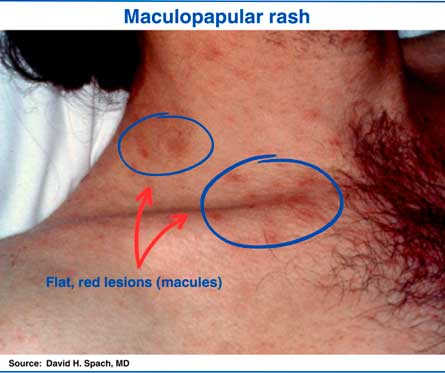
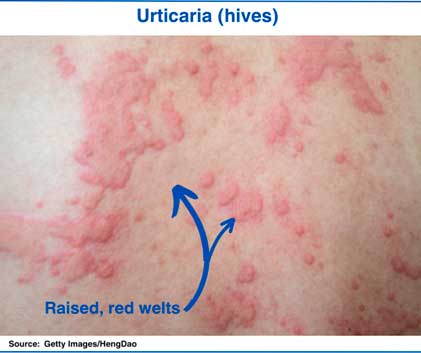
Swollen lymph nodes
How common is lymph node enlargement in early HIV?
Lymph node enlargement occurs in up to 70% of patients with acute HIV infection. [1] How to Recognize and Treat Acute HIV Syndrome. American Family Physician. https://www.aafp.org/pubs/afp/issues/1999/0801/p535.html
How soon does lymph node enlargement occur in acute HIV?
In most cases, it occurs in the second week of infection. [3] Primary HIV infection. International Journal of STD & AIDS. https://sci-hub.se/10.1258/0956462021924613
What do acute HIV lymph nodes look like?
Enlarged lymph nodes typically look like round, pea-sized bumps. However, they may be more prominent in case of severe infection. [7] HIV and Swollen Lymph Nodes. Very Well Health. https://www.verywellhealth.com/common-hiv-lymphadenopathy-questions-49596#:~:text=Lymphadenopathy%20and%20accompanying%20symptoms%20of,early%20signs%20of%20HIV%20infection.
Which lymph nodes are enlarged with acute HIV?
A distinctive feature of acute HIV is that enlarged lymph nodes are located throughout the body (most often in the neck, armpits, and groin). While other conditions result in localized enlargement of the lymph nodes (for example, strep throat causes enlargement of the lymph nodes in the neck).
[3, 7]
Primary HIV infection. International Journal of STD & AIDS.
https://sci-hub.se/10.1258/0956462021924613
HIV and Swollen Lymph Nodes. Very Well Health.
https://www.verywellhealth.com/common-hiv-lymphadenopathy-questions-49596#:~:text=Lymphadenopathy%20and%20accompanying%20symptoms%20of,early%20signs%20of%20HIV%20infection.
Are enlarged lymph nodes painful?
No. Enlarged lymph nodes in the early stages of HIV infection are usually painless or may be slightly tender to the touch. [3] Primary HIV infection. International Journal of STD & AIDS. https://sci-hub.se/10.1258/0956462021924613
How long does the lymph node enlargement last in acute HIV?
It can last anywhere from a few days to the first few weeks of exposure. Though the lymph nodes may decrease in size, local swelling may persist. [7] HIV and Swollen Lymph Nodes. Very Well Health. https://www.verywellhealth.com/common-hiv-lymphadenopathy-questions-49596#:~:text=Lymphadenopathy%20and%20accompanying%20symptoms%20of,early%20signs%20of%20HIV%20infection.
In severe cases, swollen lymph nodes may persist for more than three months. This happens when there is widespread enlargement of the lymph nodes, measuring about 1 inch (more than 2 cm). This condition is known as persistent generalized lymphadenopathy (PGL). [7] HIV and Swollen Lymph Nodes. Very Well Health. https://www.verywellhealth.com/common-hiv-lymphadenopathy-questions-49596#:~:text=Lymphadenopathy%20and%20accompanying%20symptoms%20of,early%20signs%20of%20HIV%20infection.
Headache
How common is the headache with early HIV?
About 32-70% of people with acute HIV infection experience headaches. [1] How to Recognize and Treat Acute HIV Syndrome. American Family Physician. https://www.aafp.org/pubs/afp/issues/1999/0801/p535.html
What kind of headache is it?
There is limited data on the characteristics of headaches in patients with acute HIV. It is known that some patients with early-stage HIV may experience retro-orbital pain (pain behind the eye) that gets worse with eye movement. It is also known that patients with HIV generally experience migraines, tension headaches, and, less commonly, cluster headaches, which usually intensify as the disease progresses.
[8, 9]
The impact of HIV infection on primary headache. Unexpected findings from retrospective, cross-sectional, and prospective analyses. ScienceDirect.
https://www.sciencedirect.com/science/article/abs/pii/S0304395999002663
Headache Among Patients With HIV Disease: Prevalence, Characteristics, and Associations. American Headache Society.
https://sci-hub.se/10.1111/j.1526-4610.2011.02025.x
How severe is the headache in acute HIV?
The intensity of early HIV headache can range from mild to severe.
How long does early HIV headache last?
About 32-70% of people with acute HIV infection experience headaches. [10] Clinical features of acute retroviral syndrome differ by route of infection but not by gender and age. Journal of acquired Immune Deficiency Syndrome. https://journals.lww.com/jaids/abstract/2002/11010/clinical_features_of_acute_retroviral_syndrome.7.aspx
Mouth ulcers
How common are mouth ulcers in early HIV?
Mouth ulcers occur in up to 21% of early HIV cases. [11] The acute retroviral syndrome and the pathogenesis of HIV-1 infection. Seminars in Immunology. https://sci-hub.se/10.1006/smim.1993.1018
What parts of the mouth are affected by ulcers?
Mouth ulcers may occur on gums, lips, tongue, palate, buccal mucosa (the inner lining of the cheeks), and throat. [12] Clinical,virologicalandimmunologicalfeaturesof primaryHIV-1 infection. Genitourinary Medicine. https://www.ncbi.nlm.nih.gov/pmc/articles/PMC1194734/pdf/genitmed00041-0011.pdf
Characteristics of early HIV mouth ulcers
The mouth sores are usually circular or oval and have well-defined borders, contrasting with the healthy appearance of the surrounding mucosa. The ulcers may be covered by an exudative plaque (pus or other fluid). A sign that may indicate early HIV infection is the presence of enanthem (reddish spots, rash, or other lesions) along with mouth ulcer(s). [12] Clinical,virologicalandimmunologicalfeaturesof primaryHIV-1 infection. Genitourinary Medicine. https://www.ncbi.nlm.nih.gov/pmc/articles/PMC1194734/pdf/genitmed00041-0011.pdf
Acute HIV mouth ulcer
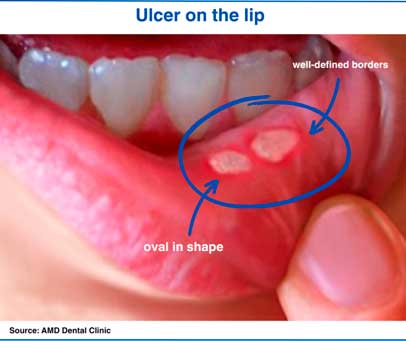
Oral thrush
How common is oral thrush in early HIV?
Around 15% of patients with acute HIV infection experience oral thrush (candidiasis). [10] Clinical features of acute retroviral syndrome differ by route of infection but not by gender and age. Journal of acquired Immune Deficiency Syndrome. https://journals.lww.com/jaids/abstract/2002/11010/clinical_features_of_acute_retroviral_syndrome.7.aspx
What parts of the mouth are affected by thrush?
The oral thrush can affect the tongue, palate, throat (causing pain when swallowing), and inner cheeks.
Early-stage HIV tongue. Oral thrush
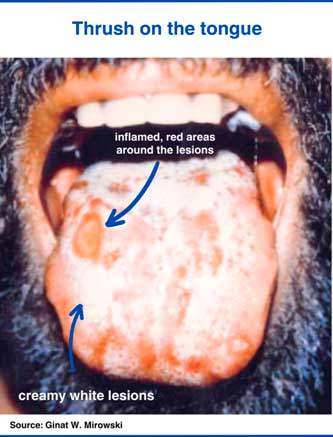
Sore throat
How common is sore throat with early HIV?
Sore throat is the most common oropharyngeal symptom among patients with acute HIV infection. It is reported by up to 37% of patients. In severe cases, the early HIV sore throat may lead to odynophagia (pain when swallowing).
[2, 3]
Acute HIV-1 Infection in the Southeastern United States: A Cohort Study. PubMed Central.
https://www.ncbi.nlm.nih.gov/pmc/articles/PMC3537297/
Primary HIV infection. International Journal of STD & AIDS.
https://sci-hub.se/10.1258/0956462021924613
Characteristics of early HIV sore throat
Acute HIV sore throat is typically non-exudative. This means there is inflammation (swelling and redness) of the back wall of the throat, but there is no pus or thick mucus on the surface of the tonsils and throat. [13] Pharyngitis. StatPearls. https://www.ncbi.nlm.nih.gov/books/NBK519550/
How long does acute HIV sore throat last?
The sore throat can last for a few days to several weeks.
Muscle pain
How common is muscle pain in early HIV?
Around 30% of patients with acute HIV report muscle pain. [3] Primary HIV infection. International Journal of STD & AIDS. https://sci-hub.se/10.1258/0956462021924613
How soon does muscle pain occur in acute HIV?
Muscle and joint pain occur in the first few weeks of exposure. [14] HIV Pain: Causes, Types, and Tips for Management. WebMD. https://www.webmd.com/hiv-aids/hiv-pain-causes-types-management-tips
How long does muscle pain last?
Acute HIV muscle pain lasts for 11 days on average. [10] Clinical features of acute retroviral syndrome differ by route of infection but not by gender and age. Journal of acquired Immune Deficiency Syndrome. https://journals.lww.com/jaids/abstract/2002/11010/clinical_features_of_acute_retroviral_syndrome.7.aspx
Characteristics of early HIV muscle pain
The pain is usually generalized, meaning it is felt throughout the body, affecting different body parts.
Unexpected weight loss
How common is unexpected weight loss with early HIV?
Weight loss occurs in approximately 35% of patients with early HIV. [2] Acute HIV-1 Infection in the Southeastern United States: A Cohort Study. PubMed Central. https://www.ncbi.nlm.nih.gov/pmc/articles/PMC3537297/
Why do patients lose weight in early HIV?
Weight loss occurs for several reasons, such as loss of appetite (around 45% of cases), nausea (44% of cases), and diarrhea (45% of cases). About 30% of patients who experience nausea and vomiting also have watery diarrhea.
[2, 3]
Acute HIV-1 Infection in the Southeastern United States: A Cohort Study. PubMed Central.
https://www.ncbi.nlm.nih.gov/pmc/articles/PMC3537297/
Primary HIV infection. International Journal of STD & AIDS.
https://sci-hub.se/10.1258/0956462021924613
Risks associated with severe and long-lasting acute HIV infection?
The duration and severity of HIV infection significantly predict disease outcomes. The longer the duration of acute HIV infection and the greater the number of symptoms, the higher the likelihood of rapid development of AIDS. [15] Predictors to rapid progression to AIDS in HIV-1 seroconverts. AIDS. https://sci-hub.se/10.1097/00002030-199301000-00008
Research shows that the chance of developing AIDS within three years of infection is 8-fold higher for patients with long-lasting (at least 14 days) early HIV symptoms compared with those who were asymptomatic or had only mild symptoms (78% vs 10%). [16] Clinical course of primary HIV infection: consequences for subsequent course of infection. BMJ. https://www.ncbi.nlm.nih.gov/pmc/articles/PMC1837064/
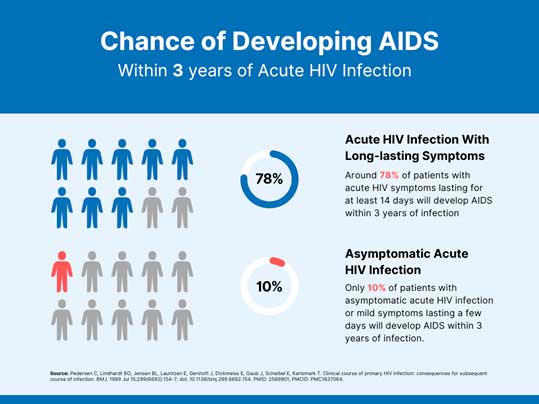
What is the chance of transmitting infection during early HIV?
The likelihood of HIV transmission is extremely high during acute HIV infection (around 10-26 times higher than with chronic infection). It is estimated that up to 50% of all HIV transmissions occur during this stage. This fact emphasizes the importance of early diagnosis and initiation of antiviral therapy.
Factors influencing the severity and duration of early HIV
What are the risk factors for getting early HIV symptoms?
Some patients are asymptomatic, while others may experience only one or two mild symptoms that resolve independently within a few days. On the other hand, some patients experience multiple acute HIV symptoms, varying in intensity from moderate to severe and lasting for weeks.
The amount of virus in the blood (viral load) determines the intensity and duration of acute HIV symptoms. The higher the viral load, the more severe and long-lasting the symptoms are. A combination of different symptoms (e.g., skin rash and fever) may also occur. [18] The Relation Between Symptoms, Viral Load, and Viral Load Set Point in Primary HIV Infection. Journal of acquired Immune Deficiency Syndrome. https://web.archive.org/web/20170810032719id_/https:/msrc.fsu.edu/system/files/Kelley%20et%20al%202007%20Relation%20Between%20Symptoms%20Viral%20Load%20and%20Viral%20Load%20Set%20Point%20in%20Primary%20HIV%20Infection.pdf
Several factors affect the viral load of the newly infected person:
✓ Host genetic factors such as human leukocyte antigen (HLA) system. HLA helps the immune system recognize and fight HIV infection, affecting the amount of virus in the blood.
✓ Mode of transmission. Most symptomatic patients get their infection via sexual intercourse. [16] Clinical course of primary HIV infection: consequences for subsequent course of infection. BMJ. https://www.ncbi.nlm.nih.gov/pmc/articles/PMC1837064/
✓ Strength of the immune system. Stronger immunity leads to lower viral load by suppressing the replication of the virus.
[18, 16]
The Relation Between Symptoms, Viral Load, and Viral Load Set Point in Primary HIV Infection. Journal of acquired Immune Deficiency Syndrome.
https://web.archive.org/web/20170810032719id_/https:/msrc.fsu.edu/system/files/Kelley%20et%20al%202007%20Relation%20Between%20Symptoms%20Viral%20Load%20and%20Viral%20Load%20Set%20Point%20in%20Primary%20HIV%20Infection.pdf
Clinical course of primary HIV infection: consequences for subsequent course of infection. BMJ.
https://www.ncbi.nlm.nih.gov/pmc/articles/PMC1837064/
✓ Viral load of the source partner. The higher the source partner's viral load, the more likely the host partner will have a high viral load early in the infection. [19] HIV RNA level in early infection is predicted by viral load in the transmission source. AIDS. https://www.ncbi.nlm.nih.gov/pmc/articles/PMC2887742/
Early signs of HIV in men and women
According to research, women are more likely to have early HIV symptoms than men, with 94% and 88.3% of symptomatic women and men, respectively. However, women tend to have a shorter duration (9 vs. 18 days) and fewer symptoms (4.5 vs. six symptoms on average) than men. [20] Acute HIV-1 Infection in the Southeastern United States: A Cohort Study. AIDS Research and Human Retroviruses. https://www.ncbi.nlm.nih.gov/pmc/articles/PMC3537297/
Age-related specificities of early HIV symptoms
In general, older people experience more severe and prolonged acute HIV infection and are more likely to develop AIDS earlier. However, age alone does not determine the severity of the disease; age-related factors such as decreased immunity and changes in general health do. [16] Clinical course of primary HIV infection: consequences for subsequent course of infection. BMJ. https://www.ncbi.nlm.nih.gov/pmc/articles/PMC1837064/
Route of transmission and early HIV symptoms
In general, people who become infected with HIV through injection drugs (sharing needles) have milder and fewer symptoms of acute infection, such as fever, fatigue, diarrhea, skin rash, muscle pain, and sore throat. For example, about 50% of patients who become infected with HIV through injection drug use report a fever, compared with about 70% of those who become infected through sexual contact. Similarly, skin rashes were reported in only 21% of people infected through injection drug use and in 50% of people who acquired HIV through sexual contact. However, genital ulcers were more common when HIV was transmitted through sexual contact (14% for heterosexual contact and 4% for homosexual contact vs. 0% for injection drug users). [10] Clinical features of acute retroviral syndrome differ by route of infection but not by gender and age. Journal of acquired Immune Deficiency Syndrome. https://journals.lww.com/jaids/abstract/2002/11010/clinical_features_of_acute_retroviral_syndrome.7.aspx
Early HIV Diagnosis and Treatment
Early HIV testing
Early HIV testing is critical for early detection, timely management, and optimal outcome of the disease. It will also prevent further transmission and disease-related complications.
In the early stage of the disease, the antibody test may fail to reveal the HIV infection since it takes a few weeks or even months to have detectable levels of antibodies. Therefore, taking the NAT (Nucleic acid test) is recommended, which detects the actual HIV in the blood (the viral load). It’s the first and most reliable test for this stage of infection. [21] Information about Acute HIV Infection and PrEP. CDC. https://www.cdc.gov/hiv/pdf/prep_gl_patient_factsheet_acute_hiv_infection_english.pdf
Early HIV treatment
To date, there is no cure for HIV. However, there is an effective treatment that helps to control HIV infection, prevent further transmission and complications, and have a long, healthy life.
The HIV treatment (antiretroviral therapy or ART) usually starts once a person is diagnosed with HIV and is composed of a combination of 3 or more medications that control HIV replication and lower the amount of virus in the blood. [21] Information about Acute HIV Infection and PrEP. CDC. https://www.cdc.gov/hiv/pdf/prep_gl_patient_factsheet_acute_hiv_infection_english.pdf
When to see a doctor
It is recommended to get screened for HIV if you have been recently experiencing early HIV signs and symptoms and had a potential exposure to infection (having unprotected sex or shared needles). Early HIV detection and treatment will significantly improve the overall prognosis. [21] Information about Acute HIV Infection and PrEP. CDC. https://www.cdc.gov/hiv/pdf/prep_gl_patient_factsheet_acute_hiv_infection_english.pdf
Source
-
How to Recognize and Treat Acute HIV Syndrome. American Family Physician.
https://www.aafp.org/pubs/afp/issues/1999/0801/p535.html -
Acute HIV-1 Infection in the Southeastern United States: A Cohort Study. PubMed Central.
https://www.ncbi.nlm.nih.gov/pmc/articles/PMC3537297/ -
Primary HIV infection. International Journal of STD & AIDS.
https://sci-hub.se/10.1258/0956462021924613 -
What to know about a fever and HIV. MedicalNewsToday.
https://www.medicalnewstoday.com/articles/323845 -
Features of fever caused by HIV virus. VinMec.
https://www.vinmec.com/en/news/health-news/general-health-check/features-of-fever-caused-by-hiv-virus/ -
Patient education: Symptoms of HIV (Beyond the Basics). UpToDate.
https://www.uptodate.com/contents/symptoms-of-hiv-beyond-the-basics -
HIV and Swollen Lymph Nodes. Very Well Health.
https://www.verywellhealth.com/common-hiv-lymphadenopathy-questions-49596#:~:text=Lymphadenopathy%20and%20accompanying%20symptoms%20of,early%20signs%20of%20HIV%20infection. -
The impact of HIV infection on primary headache. Unexpected findings from retrospective, cross-sectional, and prospective analyses. ScienceDirect.
https://www.sciencedirect.com/science/article/abs/pii/S0304395999002663 -
Headache Among Patients With HIV Disease: Prevalence, Characteristics, and Associations. American Headache Society.
https://sci-hub.se/10.1111/j.1526-4610.2011.02025.x -
Clinical features of acute retroviral syndrome differ by route of infection but not by gender and age. Journal of acquired Immune Deficiency Syndrome.
https://journals.lww.com/jaids/abstract/2002/11010/clinical_features_of_acute_retroviral_syndrome.7.aspx -
The acute retroviral syndrome and the pathogenesis of HIV-1 infection. Seminars in Immunology.
https://sci-hub.se/10.1006/smim.1993.1018 -
Clinical,virologicalandimmunologicalfeaturesof primaryHIV-1 infection. Genitourinary Medicine.
https://www.ncbi.nlm.nih.gov/pmc/articles/PMC1194734/pdf/genitmed00041-0011.pdf -
Pharyngitis. StatPearls.
https://www.ncbi.nlm.nih.gov/books/NBK519550/ -
HIV Pain: Causes, Types, and Tips for Management. WebMD.
https://www.webmd.com/hiv-aids/hiv-pain-causes-types-management-tips -
Predictors to rapid progression to AIDS in HIV-1 seroconverts. AIDS.
https://sci-hub.se/10.1097/00002030-199301000-00008 -
Clinical course of primary HIV infection: consequences for subsequent course of infection. BMJ.
https://www.ncbi.nlm.nih.gov/pmc/articles/PMC1837064/ -
Primary HIV Infection: Clinical Presentation, Testing, and Treatment. Springer.
https://sci-hub.se/https:/doi.org/10.1007/s11908-017-0588-3 -
The Relation Between Symptoms, Viral Load, and Viral Load Set Point in Primary HIV Infection. Journal of acquired Immune Deficiency Syndrome.
https://web.archive.org/web/20170810032719id_/https:/msrc.fsu.edu/system/files/Kelley%20et%20al%202007%20Relation%20Between%20Symptoms%20Viral%20Load%20and%20Viral%20Load%20Set%20Point%20in%20Primary%20HIV%20Infection.pdf -
HIV RNA level in early infection is predicted by viral load in the transmission source. AIDS.
https://www.ncbi.nlm.nih.gov/pmc/articles/PMC2887742/ -
Acute HIV-1 Infection in the Southeastern United States: A Cohort Study. AIDS Research and Human Retroviruses.
https://www.ncbi.nlm.nih.gov/pmc/articles/PMC3537297/ -
Information about Acute HIV Infection and PrEP. CDC.
https://www.cdc.gov/hiv/pdf/prep_gl_patient_factsheet_acute_hiv_infection_english.pdf

By Slava Fuzayloff. D.O
Dr. Slava Fuzayloff is practicing STD physician with 20 years of experience and expert writer in the field of the sexually transmitted diseases.

